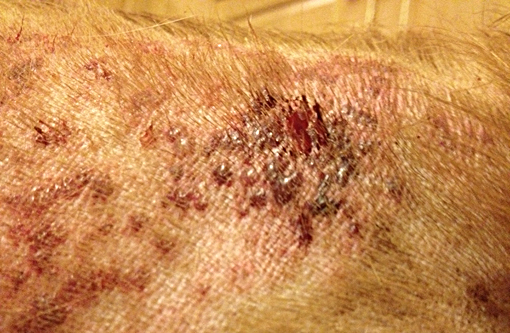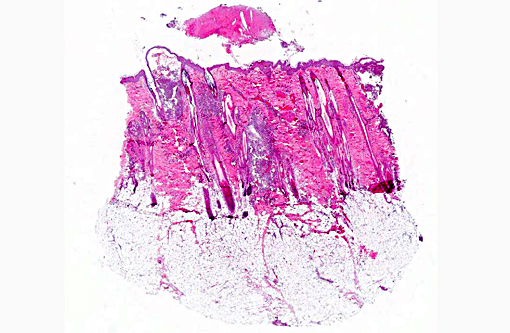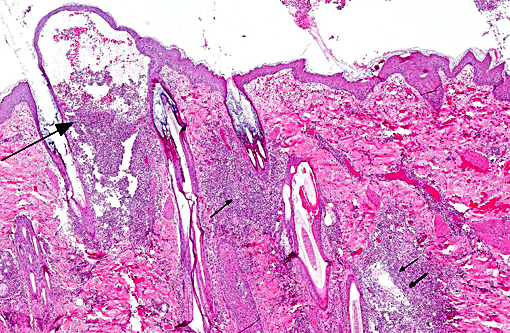Signalment:
Gross Description:
Histopathologic Description:
Morphologic Diagnosis:
Condition:
Contributor Comment:
The clinical lesions typically arise on the dorsal midline as hemorrhagic pustules and crusts. The dogs may be febrile and very painful on thoracolumbar palpation. In dogs with a dense or thick haircoat (e.g. Golden retriever), the lesions may be missed on initial examination. In fact, some patients have been worked up for discospondylitis, back pain, tick borne diseases or pancreatitis. In contrast to other causes of furunculosis (e.g. demodicosis, dermatophytosis, staphy-lococcal infection), PGF is acute. The outer root sheath is necrotic rather than hyperplastic and the rupture occurs in the superficial dermis. Furthermore, the inflammation is hemorrhagic and fibri-nosuppurative rather than pyogranulomatous. Bacteria may be difficult to discern on H&E and Gram stain as they are often small gram negative bacilli.
JPC Diagnosis:
Conference Comment:
The superficial nature of the lesions, acute onset, hemorrhage and lesions isolated to the dorsal trunk can help differentiate this condition from other causes of folliculitis and furunculosis in dogs. The predilection for lesions over the dorsum in PGF is postulated to be associated with the nature of grooming or bathing activities that may concentrate brushing and shampooing efforts on this area. The dorsum also has increased hair density and hair shaft size. Cytologic features of impression smears may include neutrophils and macrophages with or without eosinophils, red blood cells, and intracellular or extracellular bacteria. Clinicopathologic abnormalities associated with this condition may include neutrophilia, with or without a left shift, monocytosis, lymphopenia and mild thrombocytopenia. These abnormalities, when considered with the presence of fever, may suggest a systemic inflammatory response.(1)
Pseudomonas aeruginosa, a gram negative bacillus, is the most common bacterial agent associated with post grooming furunculosis. Pseudomonas aeruginosa is a common bacterial contaminant associated with water and can survive in the presence of some disinfectants. Other bacteria, such as Serratia marcescens and Burkholderia cepacia, are associated with this condition. In the veterinary setting, S. marcescens has been implicated as a contaminant of intravenous catheters, and B. cepacia has been documented as a contaminant of ear cleaning solutions.(1)
References:
1. Baxter CG, Vogelnest LJ. Multifocal papular deep bacterial pyoderma in a Boxer dog caused by Pseudomonas aeruginosa. Aust Vet J. 2008;86:435439.
2. Cain C, Mauldin EA. Clinical and histopathologic features of dorsally oriented furunculosis in dogs following water immersion or exposure to grooming products. J Am Vet Med Assoc. 2015; 246(5):522-9.
3. Hillier A, Alcorn JR, Cole LK, et al. Pyoderma caused by Pseudomonas aeruginosa infection in dogs: 20 cases. Vet Dermatol. 2006;17:432439.
4. Ihrke PJ, Gross TL. Warning about postgrooming furunculosis. J Am Vet Med Assoc. 2006;229:10811082.


